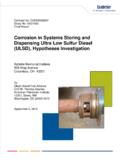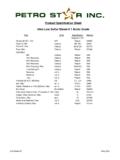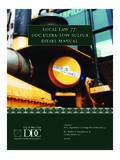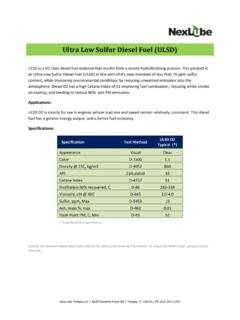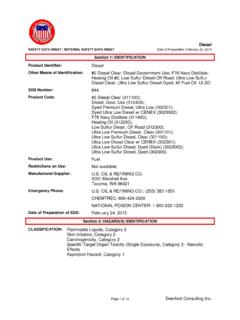Transcription of Material Safety Data Sheet Diesel Fuel#2-Low Sulfur (LS ...
1 Material Safety data Sheet Diesel Fuel#2-Low Sulfur (LS) and ultra Low Sulfur Diesel (ULSD). NFPA: Flammability HMIS III: 2 Reactivity HEALTH 1. FLAMMABILITY 2. 0 0. Health PHYSICAL 0. 0 = Insignificant, 1 = Slight, 2 = Moderate, Specific Hazard 3 = High, 4 = Extreme SECTION 1. PRODUCT AND COMPANY IDENTIFICATION. Product name : Diesel Fuel#2-Low Sulfur (LS) and ultra Low Sulfur Diesel (ULSD). Synonyms : 888100004790. MSDS Number : 888100004790 Version : Product Use Description : fuel Company : For: Tesoro Refining & Marketing Co. 300 Concord Plaza Drive, San Antonio, TX 78216-6999. Tesoro Call Center : (877) 783-7676 Chemtrec : (800) 424-9300.
2 (Emergency Contact). SECTION 2. HAZARDS IDENTIFICATION. Emergency Overview Regulatory status : This Material is considered hazardous by the Occupational Safety and Health Administration (OSHA) Hazard Communication Standard (29 CFR ). Signal Word : WARNING. Hazard Summary : Toxic Potential Health Effects Eyes : Eye irritation may result from contact with liquid, mists, and/or vapors. Skin : Skin irritation leading to dermatitis may occur upon prolonged or repeated contact. Liquid may be absorbed through the skin in toxic amounts if large areas of skin are repeatedly exposed. Long-term, repeated skin contact may cause skin cancer Ingestion : Harmful or fatal if swallowed.
3 Do NOT induce vomiting. This Material can irritate the mouth, throat, stomach, and cause nausea, vomiting, diarrhea and restlessness Aspiration hazard if liquid is inhaled into lungs, particularly from vomiting after ingestion. Aspiration may result in chemical pneumonia, severe lung damage, respiratory failure and even death. Target Organs : Kidney, Liver, Skin, Eyes, Central nervous system Material Safety data Sheet Diesel fuel #2-Low Sulfur (LS) and ultra Low Page 2 of 10. Sulfur Diesel (ULSD). Inhalation : Vapors or mists from this Material can irritate the nose, throat, and lungs, and can cause signs and symptoms of central nervous system depression, depending on the concentration and duration of exposure.
4 SECTION 3. COMPOSITION/INFORMATION ON INGREDIENTS. Component CAS-No. Weight %. Fuels, Diesel , No 2; Gasoil - unspecified 68476-34-6 100%. Naphthalene 91-20-3 - 1%. Nonane 111-84-2 - 1%. 1,2,4-Trimethylbenzene 95-63-6 1 - 5%. Xylene 1330-20-7 1 - 5%. Sulfur 7704-34-9 15 ppm maximum SECTION 4. FIRST AID MEASURES. Inhalation : Move to fresh air. Give oxygen. If breathing is irregular or stopped, administer artificial respiration. Seek medical attention immediately. Skin contact : Take off all contaminated clothing immediately. Wash off immediately with soap and plenty of water. Wash contaminated clothing before re-use.
5 If skin irritation persists, seek medical attention immediately. Eye contact : Remove contact lenses. Rinse immediately with plenty of water, also under the eyelids, for at least 15 minutes. If eye irritation persists, seek medical attention. Ingestion : Do not induce vomiting without medical advice. If a person vomits when lying on his back, place him in the recovery position. Seek medical attention immediately. Notes to physician : Symptoms: Dizziness, Discomfort, Headache, Nausea, Disorder, Vomiting, Lung oedema, Aspiration may cause pulmonary edema and pneumonitis., Liver disorders, Kidney disorders.
6 SECTION 5. FIRE-FIGHTING MEASURES. Form : Liquid Flash point : - C ( - F). Suitable extinguishing media : Carbon dioxide (CO2), Water spray, Dry chemical, Foam, Keep containers and surroundings cool with water spray. Specific hazards during fire : Fire Hazard. Do not use a solid water stream as it may scatter and spread fire. fighting Cool closed containers exposed to fire with water spray. Special protective equipment : Wear self-contained breathing apparatus and protective suit. Use personal for fire-fighters protective equipment. 2 / 10. Material Safety data Sheet Diesel fuel #2-Low Sulfur (LS) and ultra Low Page 3 of 10.
7 Sulfur Diesel (ULSD). Further information : Exposure to decomposition products may be a hazard to health. Isolate area around container involved in fire. Cool tanks, shells, and containers exposed to fire and excessive heat with water. For massive fires the use of unmanned hose holders or monitor nozzles may be advantageous to further minimize personnel exposure. Major fires may require withdrawal, allowing the tank to burn. Large storage tank fires typically require specially trained personnel and equipment to extinguish the fire, often including the need for properly applied fire fighting foam.
8 SECTION 6. ACCIDENTAL RELEASE MEASURES. Personal precautions : Evacuate nonessential personnel and remove or secure all ignition sources. Consider wind direction; stay upwind and uphill, if possible. Evaluate the direction of product travel, diking, sewers, etc. to contain spill areas. Spills may infiltrate subsurface soil and groundwater; professional assistance may be necessary to determine the extent of subsurface impact. Ensure adequate ventilation. Use personal protective equipment. Environmental precautions : Carefully contain and stop the source of the spill, if safe to do so. Protect bodies of water by diking, absorbents, or absorbent boom, if possible.
9 Do not flush down sewer or drainage systems, unless system is designed and permitted to handle such Material . The use of fire fighting foam may be useful in certain situations to reduce vapors. The proper use of water spray may effectively disperse product vapors or the liquid itself, preventing contact with ignition sources or areas/equipment that require protection. Discharge into the environment must be avoided. If the product contaminates rivers and lakes or drains inform respective authorities. Methods for cleaning up : Take up with sand or oil absorbing materials. Carefully shovel, scoop or sweep up into a waste container for reclamation or disposal - caution, flammable vapors may accumulate in closed containers.
10 Response and clean-up crews must be properly trained and must utilize proper protective equipment (see Section 8). CERCLA Hazardous substances and corresponding RQs : Naphthalene 91-20-3 100 lbs Xylene 1330-20-7 100 lbs Nonane 111-84-2 100 lbs SECTION 7. HANDLING AND STORAGE. Handling : Keep away from fire, sparks and heated surfaces. No smoking near areas where Material is stored or handled. The product should only be stored and handled in areas with intrinsically safe electrical classification. Advice on protection against : Hydrocarbon liquids including this product can act as a non-conductive flammable fire and explosion liquid (or static accumulators), and may form ignitable vapor-air mixtures in storage tanks or other containers.


